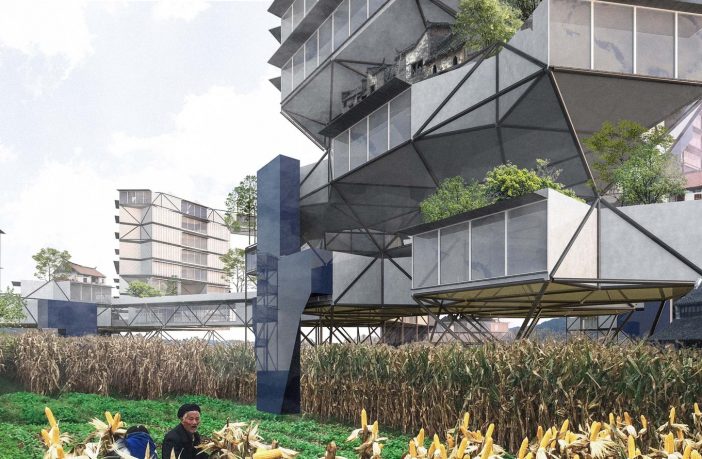To minimize the impact of the building on its site, the Lakeside Plugin Tower sits on a foundation of distributed concrete piers. The entire building is raised one story above the ground to allow for storm water to be absorbed into the ground. This aligns with China’s sponge city concept, a rethinking of the asphalt city to reduce extreme flooding and surface pollution in urban areas. The height of the elevated building also allows abundant sunlight for vegetation to flourish uninterrupted across the full site.
The entire building is prefabricated to reduce costs and allow for efficient construction. The building envelope uses a panelized system developed internally by our office and is built separately from the steel structure. The modular Plugin Panels allow for maximum flexibility throughout the life of the building. Locks are integrated into the panels allowing them to be manually installed with unskilled labor and a single tool. Over time, entire sections of each level can be extended or taken away as needed, without affecting the rest of the building. This flexibility further extends the usability of the building while reducing the likelihood of future renovation.
The building is designed using net zero building principals. The roof of the building is covered by solar panels. The Plugin Panel enclosure is manufactured using highly energy efficient rigid insulation with floor heating integrated into the floor panels. Full height operable windows allow for maximum natural ventilation. Each floor is connected to service towers that contain vertical circulation and an off-the grid sewage system that offers sustainable wastewater treatment on site.
The Lakeside Plugin Tower offers a vision housing development for new cities where buildings are integrated into a natural environment with minimal impact. It is conceived as a system rather than a one off and is an alternative of the typical government supported housing development. Examples of innovation in the project expands across scales and includes the development of new building materials, a flexible structural system that can change over time, and integrated sustainable technologies.
- ArchitectsPeople’s Architecture Office
- LocationBeijing, China
- CategoryHouses
- PrincipalZhe He, James Shen, Feng Zang
- Project TeamZhenghua Li, Ziqing Feng, Weixing Xiang, Yuxi Zhou, Guoqiang Liang, Yaxin Wang
- StructureChina Construction Steel Structure Corp. Ltd.
- Area470.0 m2
- Project Year2017
- PhotographsWeiqi Jin
This article was first published in Arch Daily and is republished with permission.






















